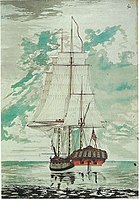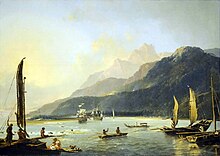Resolution (ship, 1771)
|
||||||||||||
|
||||||||||||
|
||||||||||||
|
||||||||||||
The HMS Resolution was the sailing ship of the navigator and explorer James Cook , which he used on his second and third research voyages.
history
The ship was the 14-month-old Bark Marquis of Granby , 462 tons capacity, 34 m long, almost 11 m wide and 4 m draft, a coal ship from Whitby , like Cook's very first ships and later the Endeavor , with which he made the first Pacific voyage had completed. The British Navy paid £ 4,151 for the ship, with an additional 6,565 to upgrade. Cook had 112 men on board during both voyages.
Joseph Banks , naturalist on Cook's first expedition, wanted to sail again and had extensions made that had to be removed after a test drive due to impairment of seaworthiness. Annoyed, Banks withdrew from the project two months before leaving.
The Marquis of Granby was renamed twice: first in the name of Drake , and it was only after a month that it was realized that in Spanish waters the name could be understood as a provocation to the detriment of the expedition, and the ship was christened Resolution .
Cook set sail for his second South Seas voyage on July 13, 1772 from Plymouth together with the support ship Adventure and returned to England on July 30, 1775 after 3 years, 18 days and more than 120,000 kilometers.
A year later, Cook set out on his last trip, which ended fatally for him in Hawaii in 1779 . Lieutenant Charles Clerke , previously in command of HMS Discovery , the escort ship for Cook's third expedition, then took over the leadership of the expedition and command of the resolution . However, he died on the way. He was followed by Lt. John Gore as commandant. The practical skipper during the voyage after Cook's death was navigator William Bligh , who later became known as the commander of the Bounty .
In the following years, the Resolution was a transport ship on the East-India route, where it was captured on June 9, 1782 by the French Admiral de Suffren . After that, the whereabouts of the ship becomes more difficult to trace. However, it is said that the British consul showed the Hawaiian King David Kalākaua a ship as Cook's resolution in the port of Alexandria during his world tour in 1881 .
The ship has given its name to the Resolution Head , a headland of South Georgia in the South Atlantic , since 2009 .
Web links
literature
- James Cook: Exploring the Pacific. The logbooks of the journeys 1768–1779. Edited by A. Grenfell Price. Edition Erdmann, Lenningen 2005, ISBN 3-86503-024-6 .
- Georg Forster : A voyage of discovery to Tahiti and the South Seas. 1772-1775. Re-edited by Hermann Homann. Edition Erdmann, Stuttgart et al. 1988, ISBN 3-7711-0316-9 .
Individual evidence
- ↑ cf. The Resolution
- ^ William N Armstrong: Around the world with a king . New York 1904, pp. 193f., 196

